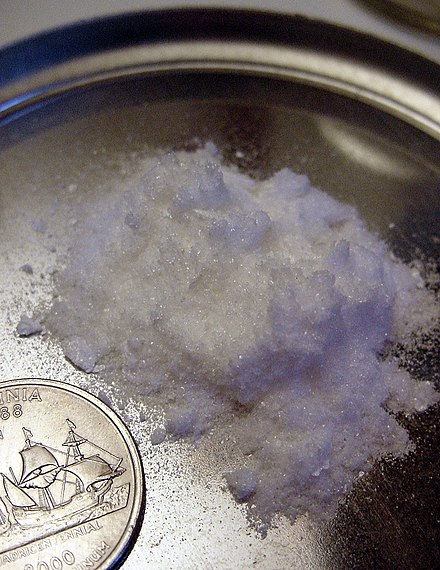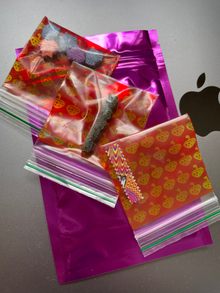
Psychedelics are a subclass of hallucinogenic drugs whose primary effect is to trigger non-ordinary mental states (known as psychedelic experiences or "trips") and a perceived "expansion of consciousness".[2][3] Also referred to as classic hallucinogens or serotonergic hallucinogens, the term psychedelic is sometimes used more broadly to include various types of hallucinogens, such as those which are atypical or adjacent to psychedelia like salvia and MDMA, respectively.[4]
Classic psychedelics generally cause specific psychological, visual, and auditory changes, and oftentimes a substantially altered state of consciousness.[5][6] They have had the largest influence on science and culture, and include mescaline, LSD, psilocybin, and DMT.[7][8]
Most psychedelic drugs fall into one of the three families of chemical compounds: tryptamines, phenethylamines, or lysergamides (LSD is considered both a tryptamine and lysergamide). They act via serotonin 2A receptor agonism.[2][9][10][11][4] When compounds bind to serotonin 5-HT2A receptors,[12] they modulate the activity of key circuits in the brain involved with sensory perception and cognition. However, the exact nature of how psychedelics induce changes in perception and cognition via the 5-HT2A receptor is still unknown.[13] The psychedelic experience is often compared to non-ordinary forms of consciousness such as those experienced in meditation,[14][3] mystical experiences,[6][5] and near-death experiences,[5] which also appear to be partially underpinned by altered default mode network activity.[15] The phenomenon of ego death is often described as a key feature of the psychedelic experience.[14][3][5]
Many psychedelic drugs are illegal to possess without lawful authorisation, exemption or license worldwide under the UN conventions, with occasional exceptions for religious use or research contexts. Despite these controls, recreational use of psychedelics is common.[16][17] Legal barriers have made the scientific study of psychedelics more difficult. Research has been conducted, however, and studies show that psychedelics are physiologically safe and rarely lead to addiction.[18][19] Studies conducted using psilocybin in a psychotherapeutic setting reveal that psychedelic drugs may assist with treating depression, alcohol addiction, and nicotine addiction.[11][20] Although further research is needed, existing results suggest that psychedelics could be effective treatments for certain forms of psychopathology.[21][22][23][17] A 2022 survey found that 28% of Americans had used a psychedelic at some point in their life.[24]

The term psychedelic was coined by the psychiatrist Humphrey Osmond during written correspondence with author Aldous Huxley (written in a rhyme: “To fathom Hell or soar angelic/Just take a pinch of psychedelic.”[25]) and presented to the New York Academy of Sciences by Osmond in 1957.[26] It is irregularly[27] derived from the Greek words ψυχή (psychḗ, meaning 'mind, soul') and δηλείν (dēleín, meaning 'to manifest'), with the intended meaning "mind manifesting" or alternatively "soul manifesting", and the implication that psychedelics can reveal unused potentials of the human mind.[28] The term was loathed by American ethnobotanist Richard Schultes but championed by American psychologist Timothy Leary.[29]
Aldous Huxley had suggested his own coinage phanerothyme (Greek phaneroein- "to make manifest or visible" and Greek thymos "soul", thus "to reveal the soul") to Osmond in 1956.[30] Recently, the term entheogen (meaning "that which produces the divine within") has come into use to denote the use of psychedelic drugs, as well as various other types of psychoactive substances, in a religious, spiritual, and mystical context.[31]
In 2004, David E. Nichols wrote the following about the nomenclature used for psychedelic drugs:[31]
Many different names have been proposed over the years for this drug class. The famous German toxicologist Louis Lewin used the name phantastica earlier in this century, and as we shall see later, such a descriptor is not so farfetched. The most popular names—hallucinogen, psychotomimetic, and psychedelic ("mind manifesting")—have often been used interchangeably. Hallucinogen is now, however, the most common designation in the scientific literature, although it is an inaccurate descriptor of the actual effects of these drugs. In the lay press, the term psychedelic is still the most popular and has held sway for nearly four decades. Most recently, there has been a movement in nonscientific circles to recognize the ability of these substances to provoke mystical experiences and evoke feelings of spiritual significance. Thus, the term entheogen, derived from the Greek word entheos, which means "god within", was introduced by Ruck et al. and has seen increasing use. This term suggests that these substances reveal or allow a connection to the "divine within". Although it seems unlikely that this name will ever be accepted in formal scientific circles, its use has dramatically increased in the popular media and on internet sites. Indeed, in much of the counterculture that uses these substances, entheogen has replaced psychedelic as the name of choice and we may expect to see this trend continue.
Robin Carhart-Harris and Guy Goodwin write that the term psychedelic is preferable to hallucinogen for describing classical psychedelics because of the term hallucinogen's "arguably misleading emphasis on these compounds' hallucinogenic properties."[32]
While the term psychedelic is most commonly used to refer only to serotonergic hallucinogens,[11][10][33][34] it is sometimes used for a much broader range of drugs, including empathogen–entactogens, dissociatives, and atypical hallucinogens/psychoactives such as Amanita muscaria, Cannabis sativa, Nymphaea nouchali and Salvia divinorum.[22][35] Thus, the term serotonergic psychedelic is sometimes used for the narrower class.[36][37] It is important to check the definition of a given source.[31] This article uses the more common, narrower definition of psychedelic.

